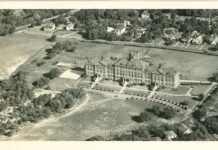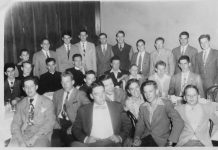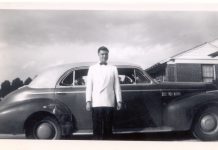
Jack Harper ’58: I am a 1958 graduate and was a classmate of Charles and Arthur. In thinking back about it I am rather surprised that it was not really a big issue with the students. It was all very natural and I guess I was unaware of what a groundbreaking situation we were involved in. I remember a few discussions regarding other schools refusing to schedule us [in football] because of Arthur. Other than that I cannot think of another issue during my entire four years at Jesuit. We saw them as fellow students and judged them on who they were and not the color of their skin. I have not seen Charles since graduation. However, I have played golf with Arthur in several Jesuit Foundation tournaments. I sat with him at a Jesuit Sports Hall of Fame dinner three years ago and told him about a young black student that I had helped get in to Jesuit. Arthur told me that he had worked with many black Jesuit students and offered to mentor him. Arthur followed up by meeting with the student’s family and offered to mentor him and help him on an ongoing basis. The student was named the freshman class “Man for Others” by the faculty. He is now a Senior. Arthur is, himself, a true “Man for Others” and I am proud to have been his classmate.
Bob Hettler ’58: I grew up in a racially tolerant family. I caddied for 3 years at Brookhollow Country Club where I was the only white guy among 30-40 black teens and adults. So when Arthur and Charlie first came to Jesuit, I felt right at home with them. I got to know Arthur right away because we played on the football team together. Arthur was a good athlete, both playing football and running track. He was outgoing and easy to get to know. Charlie was in a different homeroom and we didn’t cross paths on a day-to-day basis. From what I remember, Charlie fit in well with the student body. Jesuit embraced the idea of integration and welcomed both these students as part of the Community.
Jim Hopp ’59: I grew up in a segregated city and neighborhood in Oak Cliff. When I came to Jesuit in 1955, it was my first one on one experience with a student of a different race. I had been taught by my parents that we were to treat everyone with respect but this was my first opportunity to put that in practice on a daily basis. I remember Arthur as a friendly, scared freshman like all the rest of us. We wore our freshman beanies and tried to stay out of the way of upperclassmen, which was hard to do with the central staircase in the old Jesuit building on Oak Lawn. I recall that at least one of our football games was cancelled because the team from a town south of Dallas refused to play Jesuit since we had an African American on our team. I used the experience of getting to know Arthur during my four years at Jesuit to help guide me through the 33 years I was in the military and during my time as a permanent deacon. I have spoken of his courage and friendship many times in speeches and homilies. I was blessed to know him at Jesuit and am proud of Jesuit’s leadership in admitting Charles and Arthur as students in the mid 1950s.
Joseph Murphy ’59: As far as I was concerned there was no difference between Charles, Arthur, and any of us. Our parents sent us to Jesuit for a good education and color mattered not. I associated with Arthur more because we were both into sports. The only time I realized something was wrong was when some schools would not play games with Jesuit because we had a black player. I could not understand what was happening. To me an athlete was an athlete regardless of color. I remember drinking beer with Arthur and other players at Lake Grapevine and in Galveston, after we beat Kirwin for the state championship in football. I realize now that Arthur put up with a lot of bull I never realized [at the time]. He was tougher person than I. I wish he had played in all our games. Thinking back, other schools may have used the black thing because Arthur was just so good.
Jerry Pettibone ’59: I played football with Arthur. Arthur was a sophomore running back when I was a senior at Jesuit. We ran track together as well. Arthur was an outstanding athlete, but even a better person. The feeling among the student body was very positive, especially among the athletes.
John Stack ’58: I remember clearly Charlie Edmond joining us when I was a sophomore. In fact, I am pretty sure that at least in some classes Charlie sat in front of me. I felt totally at home with him. Even now I remember that I was proud that he was part of our class. I was delighted that Jesuit had led the way on this issue. Of course, it influenced my life in various ways. Like when I returned to teach, ’65-’68, I worked with Juanita Craft and even rode a Grey Hound with her and the NAACP to Washington, D.C. one summer. I was the only white guy on the bus and had a lot of fun with that. I even lived with Juanita during that summer.
Mike Taliaferro ’59: I was born in Houston, TX on July 26, 1941. My father’s employer transferred him to Dallas in the summer before I started the 6th grade at St. Bernard Catholic Elementary school located in the Casa Linda area of East Dallas. After graduation from elementary school, my father was promoted and the family moved to Evanston, IL and I enrolled as a freshman at Loyola Academy in the fall of 1955. My mother and my three brothers and two sisters returned to Dallas in the summer of 1956. I attended Dallas Jesuit during my second year and the first semester of my third year of high school. Segregation in Dallas in the mid 1950’s was an established and ingrained way of life. For example, there were public water fountains and public restrooms for exclusive use by white men and women and duplicate facilities clearly labeled for colored. The city buses operated by the Dallas Transit Authority dedicated space in the back for colored passengers. The great State of Texas Fair would schedule and promote a colored only day at the State Fair each year. I have a vivid recollection of Arthur Allen from our limited time together when we were student/athletes at Jesuit. He was an outstanding athlete and in my opinion his successful and smooth integration was in no small part the product of his God given athletic prowess. I can’t even begin to comprehend the road Arthur traveled on his journey to and beyond Jesuit. I look forward to reading his comments.




